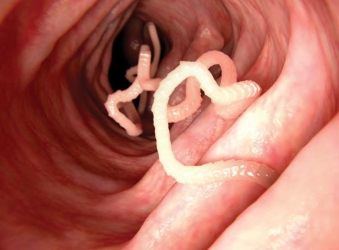  A tapeworm is a parasite that can live and feed in human intestines. The longest tapeworm ever removed from a human was 25 metres long, and was removed from a patient in India.
A tapeworm is a parasite that can live and feed in human intestines. The longest tapeworm ever removed from a human was 25 metres long, and was removed from a patient in India.A tapeworm in the intestines often causes mild symptoms. The severity of symptoms depends in part on the number and type of tapeworms. Moderate to severe symptoms may include stomach pain, hunger pains, weight loss, gas and diarrhea. Tapeworm infections are treated with anti-parasitic drugs. A young and inactive form of the tapeworm is called a larval cyst. Cysts can stay alive in other parts of the body, and can cause serious disease if they end up in a person's brain, liver, lungs, heart or eyes. Treatments for larval cyst infections may include anti-parasitic drugs, as well as surgery to remove the cyst. Other drugs may be used to treat symptoms. Most tapeworms need two different hosts to complete their life cycle. One host is the place where a parasite grows from egg to larva, called the intermediate host. The other host is where the larvae become adults, called the definitive host. For example, beef tapeworms need cattle and humans to go through a complete life cycle.  Beef tapeworm eggs can survive in the environment for months or years. If a cow, the intermediate host, eats grass with these eggs on it, the eggs hatch in its intestines. The young parasite, called a larva, passes into the bloodstream and moves to the muscles. It forms a cyst. When people, the definitive host, eat undercooked meat from that cow, they can develop a tapeworm infection. The larval cyst develops into an adult tapeworm. The tapeworm attaches to the wall of the intestine where it feeds. It produces eggs that pass in the person's stool. In this example, the cow is called the intermediate host, and the person is the definitive host.
Beef tapeworm eggs can survive in the environment for months or years. If a cow, the intermediate host, eats grass with these eggs on it, the eggs hatch in its intestines. The young parasite, called a larva, passes into the bloodstream and moves to the muscles. It forms a cyst. When people, the definitive host, eat undercooked meat from that cow, they can develop a tapeworm infection. The larval cyst develops into an adult tapeworm. The tapeworm attaches to the wall of the intestine where it feeds. It produces eggs that pass in the person's stool. In this example, the cow is called the intermediate host, and the person is the definitive host.
Humans are the definitive hosts for several species of tapeworms. They can get a tapeworm infection after eating raw or undercooked beef, pork, or fish. Humans can also be the intermediate hosts for other tapeworm species. This usually happens when they drink water or eat food with tapeworm eggs. Humans can also be exposed to eggs in dog feces. As an intermediate host, a person will have eggs hatch in their intestines. The larvae travel through the bloodstream and form cysts somewhere in the body. When a larval cyst matures, it doesn't become a tapeworm. If a cyst bursts, it can lead to cysts forming in other parts of the body. Symptoms usually show up years after the infection began. They happen when the immune system responds to the cyst breaking down. Symptoms also appear when one or more cysts keep an organ from working correctly. Pork tapeworms are different. Humans can be either a definitive host or an intermediate host for pork tapeworms. For example, a person can have adult pork tapeworms from eating undercooked pork. The eggs pass in the person's stool. Poor handwashing may lead to the same person or another person being exposed to the eggs. If this happens, a person can get a larval cyst infection. The most obvious sign of a tapeworm infection is seeing proglottids in your stool. Proglottids are egg-containing segments of tapeworms that break away from the head and neck of the parasite. They're whiteish and look like little grains of white rice that may be moving. Risk factors Factors that may put you at greater risk of tapeworm or larval cyst infection include:
Prevention These steps can help prevent infections from tapeworms or tapeworm larval cysts.
Sushi  The fish tapeworm, reaching lengths of 9 metres, is the largest that infects humans, and is found in the northern U.S. and Canada. Infection can occur after eating any raw or undercooked freshwater fish, including salmon, trout, perch, and pike.
The fish tapeworm, reaching lengths of 9 metres, is the largest that infects humans, and is found in the northern U.S. and Canada. Infection can occur after eating any raw or undercooked freshwater fish, including salmon, trout, perch, and pike. While rare, hospital visits for tape worms are on the rise. Because of the popularity of sushi and sashimi, there is an increase in tapeworm infections. While still rare, there is always the possibility of being infected if restaurants have not followed the recommended guidelines. |